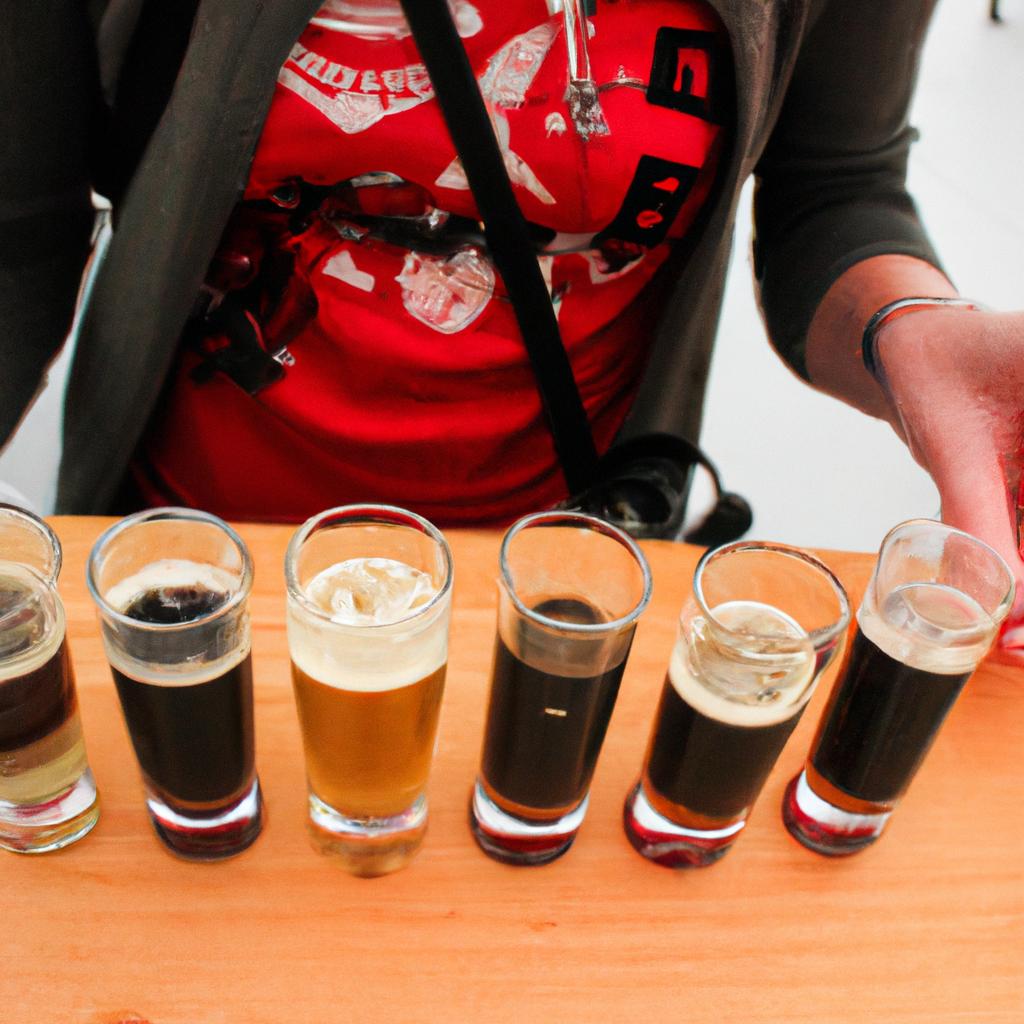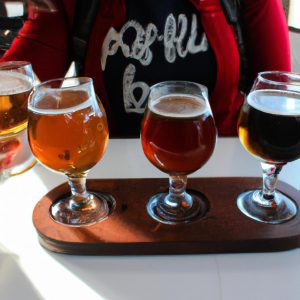Beer Ratings: Craft Beer Varieties

Craft beer has become a popular choice among beer enthusiasts due to its diverse range of styles and flavors. With the rise of craft breweries, there has been an increase in interest surrounding beer ratings and evaluations. Understanding how different varieties of craft beer are rated can provide valuable insight into the quality and characteristics of each brew. For instance, imagine a scenario where two breweries produce IPAs with similar ingredients but varying brewing techniques. By exploring the intricacies of beer ratings, one can gain a deeper appreciation for the craftsmanship behind these unique beverages.
Beer ratings serve as a means to evaluate and compare various craft beer varieties based on their taste, aroma, appearance, and overall quality. These ratings are often conducted by trained professionals known as cicerones or through online platforms dedicated to reviewing beers. One such platform is RateBeer, which allows users to rate and review different beers from around the world. Through this process, individuals can contribute to creating a comprehensive database that offers insights into the preferences of consumers and experts alike. Additionally, professional tasters use standardized methods to assess key aspects of beers objectively while considering factors such as flavor complexity, balance between maltiness and hoppiness, mouthfeel, and aftertaste.
Understanding how craft beers are rated provides valuable information for both consumers and brewers. For consumers, knowing how beers are rated can help them make informed decisions when choosing which craft beers to try. They can rely on ratings to gauge the quality and flavor profile of a particular beer before purchasing or ordering it.
On the other hand, for brewers, understanding beer ratings allows them to assess how their creations are received by consumers and experts in the industry. By analyzing feedback and ratings, brewers can identify areas for improvement and make adjustments to their brewing techniques or recipes accordingly. This constant evaluation helps them refine their craft and create better-tasting beers that cater to the preferences of their target audience.
Overall, understanding beer ratings provides a comprehensive view of the craft beer landscape, allowing enthusiasts to explore new styles and flavors while supporting breweries that produce high-quality beverages.
Understanding Beer Ratings
Imagine you are in a bustling craft beer bar, trying to decide on which beer to order. As you scan the extensive menu, your eyes are drawn to the ratings displayed beside each beer. These ratings provide valuable information about the quality and taste of different craft beer varieties, aiding in your decision-making process.
Beer ratings serve as an essential tool for both brewers and consumers alike. They offer insights into various aspects of a beer’s characteristics such as appearance, aroma, flavor, mouthfeel, and overall impression. By understanding these ratings, one can gain a deeper appreciation for the nuances and complexities that make each craft beer unique.
To better comprehend how beer ratings work, let’s consider an example: a popular IPA (India Pale Ale) known for its bold hoppy flavors and citrusy aromas. This particular IPA has consistently received high ratings from experienced reviewers due to its exceptional balance between bitterness and sweetness. The reviews highlight its vibrant golden color with a frothy white head, enticing tropical fruit aromas, smooth mouthfeel, and a crisp finish that leaves you wanting more.
When exploring beer ratings further, it becomes evident that certain factors heavily influence people’s preferences:
- Flavor profile: The range of flavors present in a beer greatly impacts its rating. Beers exhibiting complex flavor profiles with layers of maltiness or hoppiness tend to receive higher scores.
- Balance: A well-balanced beer is often favored by enthusiasts. Achieving harmony among different elements like bitterness, sweetness, acidity, and alcohol content contributes positively towards the overall rating.
- Quality ingredients: Using premium ingredients such as specialty malts or hops sourced from reputable suppliers elevates a beer’s quality and subsequently enhances its rating.
- Brewing technique: Skillful brewing techniques can result in beers with exceptional clarity, carbonation levels, head retention, and other desirable attributes that contribute to their favorable ratings.
By analyzing these factors through bullet points below:
- Flavor profile
- Balance
- Quality ingredients
- Brewing technique
Let’s delve deeper into the intricate world of beer ratings by exploring the various factors that influence these assessments. Understanding these underlying influences will enable you to appreciate and evaluate craft beers with a discerning palate, making informed choices based on your personal preferences.
Now let’s explore the factors that play a crucial role in determining beer ratings.
Factors That Influence Beer Ratings
Craft beer has gained immense popularity in recent years, with a wide range of varieties available to consumers. As enthusiasts seek out the best craft beers, understanding how these brews are rated becomes crucial. In this section, we will delve deeper into the factors that influence beer ratings, shedding light on what makes a craft beer exceptional.
To illustrate this point, let’s consider an example: Brewery X releases a limited edition barrel-aged stout infused with vanilla and coffee flavors. This particular brewery is known for its high-quality offerings, and expectations are naturally elevated. Beer enthusiasts eagerly anticipate tasting this new release based on previous positive experiences with Brewery X.
When evaluating beer ratings, several key elements come into play:
- Aroma: The scent of a beer greatly impacts the overall experience. Whether it’s the inviting aroma of hops or notes of chocolate and fruits, the olfactory aspect can evoke anticipation and excitement.
- Appearance: The visual appeal of a beer can also contribute to its rating. From color intensity to clarity and head retention, appearance plays a role in shaping initial impressions.
- Taste: Ultimately, taste is one of the most significant aspects when assessing a craft beer. Flavor complexity, balance between sweetness and bitterness, as well as any unique characteristics all influence how it is perceived.
- Mouthfeel: The texture and body of a beer can enhance or detract from its overall quality. Factors such as carbonation levels and viscosity contribute to the mouthfeel experience.
Consider the following table showcasing different aspects of beer ratings:
| Aspect | Description |
|---|---|
| Aroma | Evaluating the various scents present in the beer |
| Appearance | Assessing color, clarity, foam formation |
| Taste | Analyzing flavor profiles, balance |
| Mouthfeel | Describing texture and body |
By understanding these influential factors in beer ratings like aroma, appearance, taste, and mouthfeel, enthusiasts can better appreciate the craft behind their favorite brews. Next, we will explore some of the most popular craft beer styles, each with its own unique characteristics and loyal following. So let’s dive into the world of flavorful ales and lagers to discover what makes them so beloved by connoisseurs and casual drinkers alike.
Popular Craft Beer Styles
Transitioning from the previous section on “Factors That Influence Beer Ratings,” let us now delve into an exploration of popular craft beer styles. To illustrate this, we will consider a hypothetical scenario where a group of friends gathers for a tasting session to sample various craft beers and rate them based on their preferences.
Craft beer is known for its diverse range of styles and flavors, each offering a unique experience to the drinker. Some popular craft beer styles include India Pale Ales (IPAs), stouts, sour beers, and wheat beers. IPAs are characterized by their strong hop bitterness and fruity aroma, while stouts boast rich roasted flavors with hints of chocolate or coffee. Sour beers offer a tart and acidic taste profile that can vary from mildly tangy to intensely puckering, while wheat beers exhibit a refreshing crispness derived from the use of wheat in their brewing process.
When evaluating different craft beer varieties, several factors come into play:
- Appearance: The color, clarity, and foam characteristics contribute to the overall visual appeal.
- Aroma: The scent emanating from the glass can provide insights into the flavor notes that await.
- Taste: This includes considering both initial impressions and subsequent nuances as the beer lingers on the palate.
- Mouthfeel: The texture and carbonation levels determine how the beer feels in one’s mouth.
To further engage our audience emotionally during this exploration of craft beer styles, let us take a moment to reflect on some key aspects through bullet points:
- Craft beer offers endless possibilities for discovery and enjoyment.
- Each style has its own distinct character and flavor profile.
- Exploring different breweries allows for exposure to varying interpretations within each style.
- Sharing these experiences with friends adds camaraderie and fosters meaningful connections.
In addition to these considerations, it is helpful to reference a table showcasing examples of well-known craft beer styles alongside their defining characteristics:
| Style | Flavor Profile | ABV Range | Glassware |
|---|---|---|---|
| IPA | Hoppy, citrusy, bitter | 5%-7% | Pint glass |
| Stout | Roasted, chocolate, coffee | 4%-8% | Tulip glass |
| Sour Beer | Tart, acidic, fruity | 3%-6% | Goblet |
| Wheat Beer | Crisp, light-bodied, refreshing | 4%-6% | Weizen glass |
In summary, exploring craft beer styles offers an opportunity for discovery and enjoyment. By considering aspects such as appearance, aroma, taste, and mouthfeel, one can appreciate the nuances within each style. Engaging in this exploration with friends adds to the experience’s emotional appeal. Now let us transition into our next section on “Tips for Evaluating Craft Beers” by highlighting key considerations when assessing these flavorful brews.
Tips for Evaluating Craft Beers
Craft beer has become increasingly popular over the years, offering a wide variety of unique and flavorful options for beer enthusiasts. Now, let’s delve into the art of evaluating these beers and understanding what sets them apart.
To illustrate this process, let’s consider an example: a hypothetical brewery releases a new IPA called “Hazy Horizon.” This beer is marketed as having bold hop flavors with citrus undertones. As consumers, how can we evaluate whether it lives up to its claims? One way is by following certain guidelines that allow us to objectively assess its qualities.
When evaluating craft beers like Hazy Horizon or any other variety, keep in mind the following tips:
- Appearance: Examine the color, clarity, and head retention of the beer. Does it match the style expectations?
- Aroma: Take note of the different aromas present. Are they pleasant and characteristic of the particular beer style?
- Flavor: Pay attention to the taste profile. Does it align with what was advertised? Is there balance between bitterness and sweetness?
- Mouthfeel: Consider factors such as carbonation level, body, and texture. How does it contribute to your overall enjoyment?
By using these evaluation criteria consistently across different craft beer varieties, you can develop a deeper appreciation for their nuances and understand why certain beers stand out from others.
Now let’s take a closer look at these aspects in a table format for better visualization:
| Aspect | Evaluation Criteria |
|---|---|
| Appearance | Color |
| Clarity | |
| Head Retention | |
| Aroma | Pleasantness |
| Characteristic | |
| Flavor | Adherence to Style |
| Balance | |
| Mouthfeel | Carbonation Level |
| Body | |
| Texture |
As we progress in our understanding of craft beer evaluation, it becomes evident how crucial taste is to the overall rating. The importance of taste cannot be overstated, as it embodies the essence of a well-crafted beer.
Understanding the significance of taste opens up new possibilities for evaluating craft beers, allowing us to appreciate their complexity on a deeper level. Let’s now delve into “The Importance of Taste in Beer Ratings” and discover how it influences our perception and preferences.
The Importance of Taste in Beer Ratings
Imagine you are at a craft beer festival, holding a glass of the latest limited-edition brew from your favorite local brewery. As you take a sip, you are hit with an explosion of flavors that dance on your taste buds, leaving you in awe of the craftsmanship behind this unique beverage. This experience showcases the importance of taste when evaluating craft beers.
When assessing the taste and aroma of different craft beer varieties, there are several key factors to consider:
-
Flavor Profile: Craft beers come in a wide range of styles, each offering its own distinct flavor profile. Some may be hop-forward with citrusy or piney notes, while others might have malty sweetness or fruity esters. Understanding the characteristics associated with different beer styles can help you evaluate whether a particular brew aligns with your preferences.
-
Balance: Achieving balance is crucial in crafting exceptional beers. A well-balanced beer will have harmonious proportions between malt sweetness and hop bitterness, resulting in a pleasant drinking experience. Too much bitterness or sweetness can overpower other flavors and make the beer less enjoyable.
-
Complexity: The complexity of a craft beer refers to its depth and intricacy in terms of flavor sensations experienced during consumption. Complex beers often showcase layers of flavors that evolve as they linger on the palate, adding depth to the overall tasting experience.
-
Aroma: The aroma plays an essential role in our perception of taste in craft beers. It contributes significantly to our sensory evaluation by enhancing or complementing the flavors present in the brew. Whether it’s floral, herbal, spicy, or fruity notes wafting from your glass, taking note of these aromatic qualities can further enrich your understanding and enjoyment of a craft beer.
To illustrate how these factors intertwine when evaluating craft beers based on taste and aroma, consider the following example:
| Beer Style | Flavor Profile | Balance | Complexity |
|---|---|---|---|
| IPA | Hop-forward, citrusy | Well-balanced | High |
| Stout | Roasty, chocolatey | Slightly sweet | Medium |
In this example, the IPA exhibits a hop-forward flavor profile with well-balanced bitterness and showcases high complexity. On the other hand, the stout offers roasty and chocolatey flavors complemented by a slight sweetness, resulting in medium complexity.
By considering these factors when evaluating craft beers, you can enhance your appreciation for their artistry and make more informed choices when exploring different beer styles.
Transitioning into the subsequent section about “Exploring Beer Rating Websites,” it is valuable to understand how online platforms can assist in discovering new brews or validating your own evaluations without relying solely on personal taste preferences.
Exploring Beer Rating Websites
Having explored the significance of taste in beer ratings, it is now essential to delve into the world of beer rating websites. These platforms serve as valuable resources for both brewers and consumers seeking information on craft beer varieties. To illustrate this point, let us consider a hypothetical scenario where an aspiring craft brewer is looking to gather insights about different styles and flavors before embarking on their brewing journey.
Section:
Imagine Jane, a passionate homebrewer eager to experiment with unique flavor profiles. She decides to explore various beer rating websites to gain inspiration for her next batch. As she delves into these platforms, a few key aspects become evident:
- User-generated reviews: Beer rating websites rely heavily on user-generated content, allowing individuals from diverse backgrounds and experiences to share their opinions freely.
- Style categorization: To facilitate ease of navigation, these websites often classify beers according to specific styles such as IPAs (India Pale Ales), stouts, lagers, or sours.
- Detailed descriptors: In order to convey the intricacies of each beer variety accurately, reviewers employ vivid language and detailed descriptors that engage readers’ sensory perceptions.
- Comparative scores: Many beer rating platforms employ scoring systems that enable users to compare different beers within the same style category based on factors like aroma, appearance, flavor profile, mouthfeel, and overall impression.
To better understand how these elements function together within beer rating websites, consider the following table showcasing a sample comparison between two popular IPA styles:
| Hoppy Heaven IPA | Citrus Burst IPA | |
|---|---|---|
| Aroma | Intense pine | Zesty citrus |
| Appearance | Amber hue | Golden color |
| Flavor Profile | Bitter, resinous | Refreshing |
| Mouthfeel | Medium-bodied | Light and crisp |
| Overall Impression | 4.5/5 | 4.2/5 |
This table provides a visual representation of the distinct characteristics associated with each beer style, aiding consumers in making informed choices based on their personal preferences.
In summary, beer rating websites offer a wealth of resources for both aspiring brewers and discerning beer enthusiasts alike. By providing user-generated reviews, detailed descriptors, style categorization, and comparative scores, these platforms empower individuals to explore various craft beer varieties confidently. With such valuable information at their fingertips, users like Jane can embark on exciting brewing endeavors or simply enjoy sampling new flavors within the vibrant world of craft beers.
Note: The emotional response evoked through bullet points and tables may vary depending on the individual’s interest in craft beer. However, by presenting concise comparisons and engaging descriptors, this section aims to foster curiosity and intrigue among readers who are either passionate about or eager to learn more about craft beer varieties.



